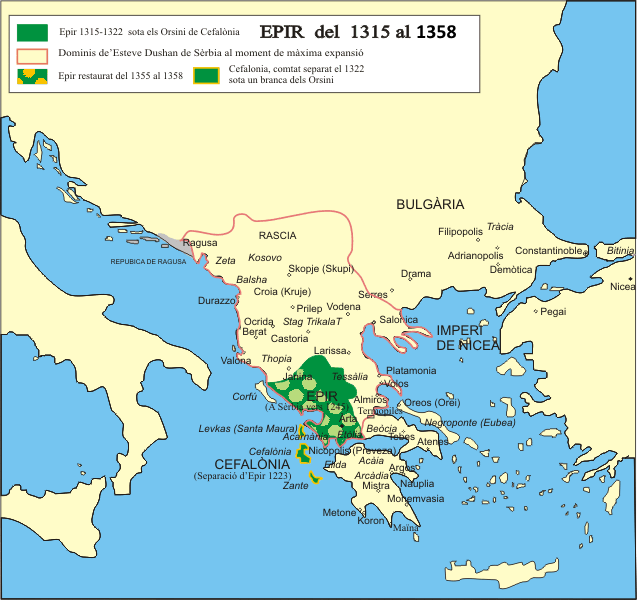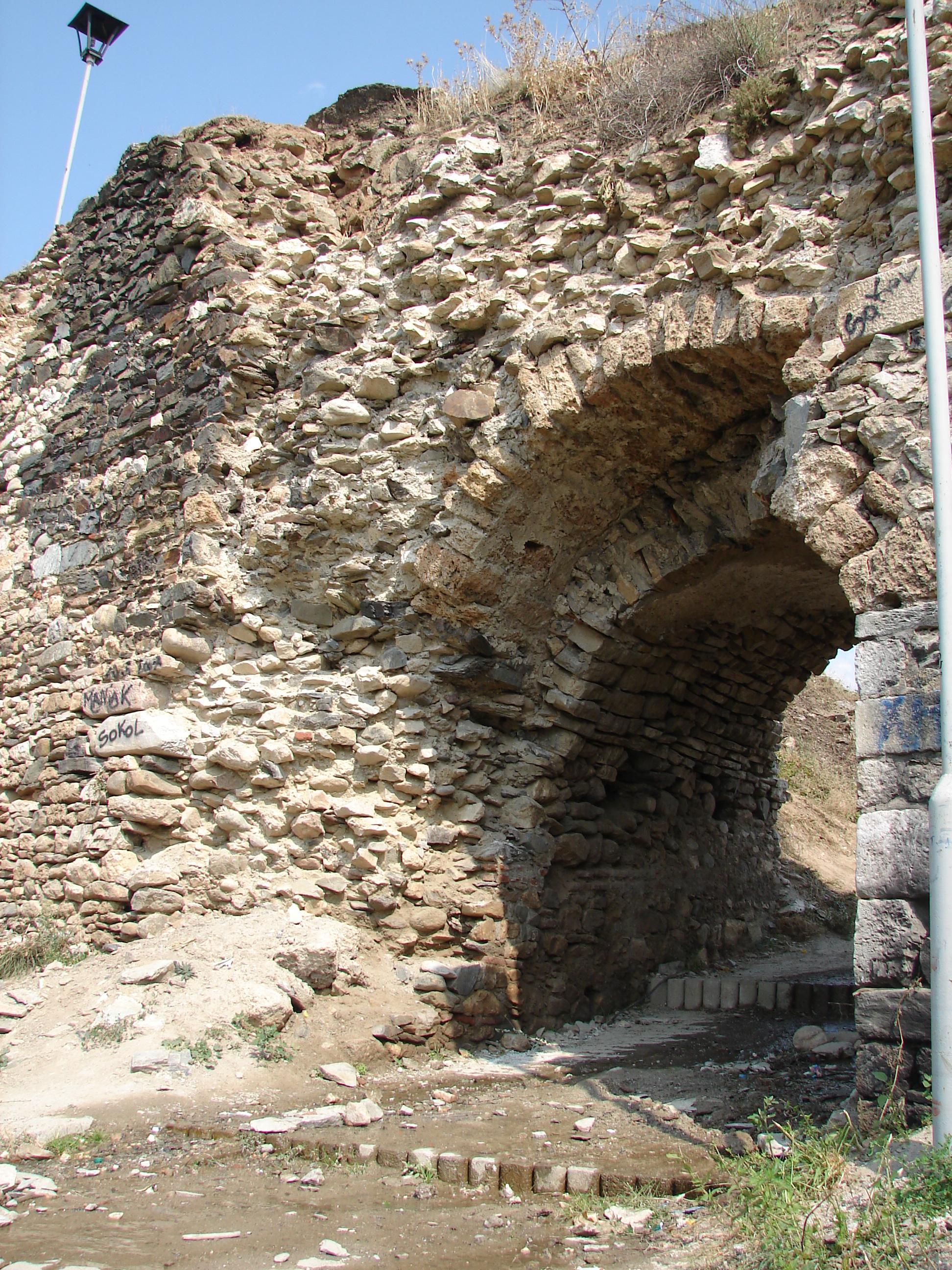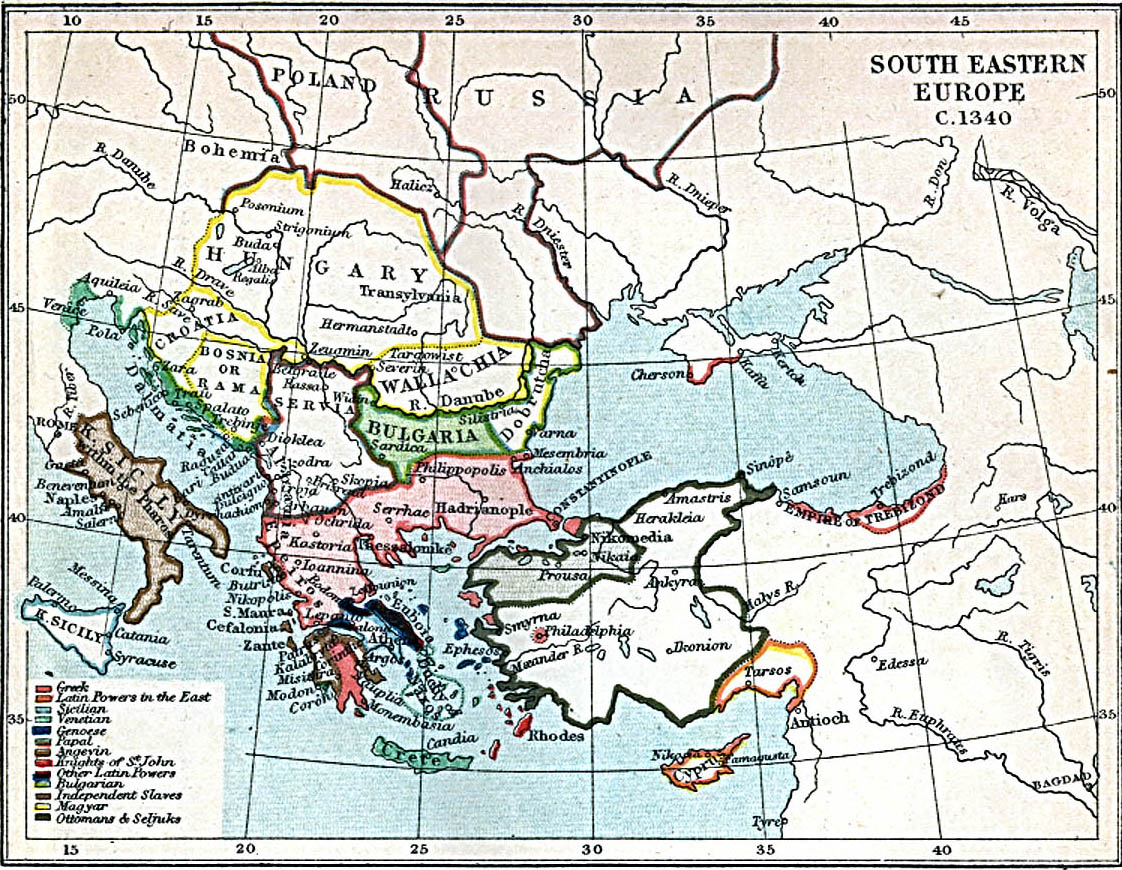|
Nikephoros II Orsini
Nikephoros II Orsini Doukas (Greek: Νικηφόρος Β΄ Δούκας, ''Nikēphoros II Doukas''), was the ruler of Epirus from 1335 to 1338 and from 1356 until his death in 1359. Life Nikephoros was the son of John Orsini of Epirus and Anna Palaiologina. When his mother allegedly poisoned his father in 1335, Nikephoros II succeeded as a 7-year-old child. His mother Anna assumed the regency for her young son but failed to allay the enmity of the Byzantine Emperor Andronikos III Palaiologos, who invaded and annexed the Epirote part of Thessaly in 1336 and advanced on Ioannina. The Albanians took advantage of conflict to the south to raid the Byzantine possessions in the north, but were defeated by the emperor in 1337. Andronikos summoned Anna to negotiate in 1338 but refused to accept her son as Byzantine vassal and installed his governors in Epirus. Keeping Anna as hostage, Andronikos arranged for the marriage between Nikephoros and Maria Kantakouzene, the daughter of his r ... [...More Info...] [...Related Items...] OR: [Wikipedia] [Google] [Baidu] |
Theodore Synadenos
Theodore Komnenos Doukas Palaiologos Synadenos (,. ca. 1277 – ca. 1346), usually simply Theodore Synadenos, was a Byzantine magnate, senior official and military leader of the early 14th century, who played an important role in the civil wars of the period. The scion of a noble lineage, he became one of the first and most prominent supporters of Andronikos III Palaiologos in his struggle against his grandfather Andronikos II. Synadenos held various provincial governorships during Andronikos III's reign, including Epirus and Thessalonica. After the outbreak of the civil war of 1341–1347, he tried to surrender Thessalonica to his old friend John Kantakouzenos, but was driven from the city by the Zealots of Thessalonica. Forced to join Kantakouzenos's enemies, he was initially honoured with the high rank of ''protovestiarios'' but soon placed under house arrest in Constantinople, where he died impoverished in 1345 or 1346. Biography Theodore Synadenos was a son of the ''m ... [...More Info...] [...Related Items...] OR: [Wikipedia] [Google] [Baidu] |
Thomais Orsini
Thomais Orsini (born c. 1330 - ) was the queen consort of the Medieval Serbia, Serbian tsar and ruler of Despotate of Epirus, Epirus and Thessaly, Simeon Uroš Nemanjić.Fine, John Van Antwerp (1994), The Late Medieval Balkans: A Critical Survey from the Late Twelfth Century to the Ottoman Conquest. University of Michigan Press, ISBN 978-0-472-08260-5. Early life Born Thomais Komnene Angelina in the early 1330s, she lost her father John II Orsini in 1335, when he was poisoned, allegedly by his wife, Anna Palaiologina (daughter of Andronikos Angelos Palaiologos), Anna Palaiologina, a scion of the ruling Palaiologos, Palaiologos dynasty of the Byzantine Empire. After John II's death, his wife Anna became regent of the Despotate of Epirus for Thomais' brother, Nikephoros II Orsini, Nikephoros II. Soon, however, in 1338, the Orsini were evicted from Epirus by the Byzantine emperor Andronikos III Palaiologos, who annexed Epirus to the Byzantine Empire. Nevertheless, during the destru ... [...More Info...] [...Related Items...] OR: [Wikipedia] [Google] [Baidu] |
Simeon Uroš
Simeon Uroš ( sr-Cyrl, Симеон Урош, ; 1326–1370), nicknamed Siniša (), was a self-proclaimed Emperor of Serbs and Greeks, from 1356 to 1370. He was son of Serbian King Stephen Uroš III and Byzantine Princess Maria Palaiologina. Initially, he was awarded the title of despot in 1346, and appointed governor of southern Epirus and Acarnania in 1347 by his half-brother, Serbian Emperor Stephen Dušan. After Dušan's death in 1355, the Serbian throne passed to Dušan's son Stephen Uroš V, but despot Simeon decided to seize the opportunity in order to impose himself as co-ruler and lord of all southern provinces of the Serbian Empire. That led him to conflict with his nephew in 1356, when Simeon started to expand his control in southern regions of the Empire, trying to take Thessaly and Macedonia. He proclaimed himself ''Emperor of the Serbs and Greeks'', creating a separate state, centered in regions of Thessaly and Epirus, where he ruled until his death in 1370. ... [...More Info...] [...Related Items...] OR: [Wikipedia] [Google] [Baidu] |
Greece
Greece, officially the Hellenic Republic, is a country in Southeast Europe. Located on the southern tip of the Balkan peninsula, it shares land borders with Albania to the northwest, North Macedonia and Bulgaria to the north, and Turkey to the east. The Aegean Sea lies to the east of the Geography of Greece, mainland, the Ionian Sea to the west, and the Sea of Crete and the Mediterranean Sea to the south. Greece has the longest coastline on the Mediterranean Basin, spanning List of islands of Greece, thousands of islands and nine Geographic regions of Greece, traditional geographic regions. It has a population of over 10 million. Athens is the nation's capital and List of cities and towns in Greece, largest city, followed by Thessaloniki and Patras. Greece is considered the cradle of Western culture, Western civilisation and the birthplace of Athenian democracy, democracy, Western philosophy, Western literature, historiography, political science, major History of science in cl ... [...More Info...] [...Related Items...] OR: [Wikipedia] [Google] [Baidu] |
Serbian Empire
The Serbian Empire ( sr-Cyrl-Latn, Српско царство, Srpsko carstvo, separator=" / ", ) was a medieval Serbian state that emerged from the Kingdom of Serbia. It was established in 1346 by Dušan the Mighty, who significantly expanded the state. During Dušan's rule, Serbia was one of the most powerful European states and, the most powerful in Southeast Europe. It was an Eastern Orthodox multi-ethnic and multi-lingual empire that stretched from the Danube in the north to the Gulf of Corinth in the south, with its capital in Skopje. Dušan also promoted the Serbian Archbishopric to the Serbian Patriarchate. In the Serbian Empire, the region of Kosovo was the most prosperous and densely populated area, serving as a key political, religious, and cultural center. Dušan's son and successor, Uroš the Weak, struggled to maintain his father's vast empire, gradually losing much of the conquered territory - hence his epithet. The Serbian Empire effectively ended wit ... [...More Info...] [...Related Items...] OR: [Wikipedia] [Google] [Baidu] |
Stefan Dušan
Stephen (honorific), Stefan Uroš IV Dušan ( sr-Cyrl, Стефан Урош IV Душан), also known as Dušan the Mighty ( sr-Cyrl, Душан Силни; – 20 December 1355), was the King of Serbia from 8 September 1331 and Emperor of the Serbs, Emperor of the Serbs, Greeks, Bulgarians and Albanians from 16 April 1346 until his death in 1355. Dušan is considered one of the greatest medieval Balkan conquerors. Dušan conquered a large part of southeast Europe, becoming one of the most powerful monarchs of the era. Under Dušan's rule, Serbia was the most powerful state in Southeast Europe and one of the most powerful European states. It was an Eastern Orthodoxy, Eastern Orthodox, multi-ethnic, and multilingual empire that stretched from the Danube in the north to the Gulf of Corinth in the south, with its capital in Skopje. He enacted the constitution of the Serbian Empire, known as Dušan Code, perhaps the most important List of medieval Serbian literature, literary work ... [...More Info...] [...Related Items...] OR: [Wikipedia] [Google] [Baidu] |
Tsar
Tsar (; also spelled ''czar'', ''tzar'', or ''csar''; ; ; sr-Cyrl-Latn, цар, car) is a title historically used by Slavic monarchs. The term is derived from the Latin word '' caesar'', which was intended to mean ''emperor'' in the European medieval sense of the term—a ruler with the same rank as a Roman emperor, holding it by the approval of another emperor or a supreme ecclesiastical official—but was usually considered by Western Europeans to be equivalent to "king". Tsar and its variants were the official titles in the First Bulgarian Empire (681–1018), Second Bulgarian Empire (1185–1396), the Kingdom of Bulgaria (1908–1946), the Serbian Empire (1346–1371), and the Tsardom of Russia (1547–1721). The first ruler to adopt the title ''tsar'' was Simeon I of Bulgaria. Simeon II, the last tsar of Bulgaria, is the last person to have held this title. Meaning in Slavic languages The title tsar is derived from the Latin title for the Roman emperors, ''c ... [...More Info...] [...Related Items...] OR: [Wikipedia] [Google] [Baidu] |
Byzantine Civil War Of 1352-1357
The Byzantine Empire, also known as the Eastern Roman Empire, was the continuation of the Roman Empire centred on Constantinople during late antiquity and the Middle Ages. Having survived the events that caused the fall of the Western Roman Empire in the 5th centuryAD, it endured until the fall of Constantinople to the Ottoman Empire in 1453. The term 'Byzantine Empire' was coined only after its demise; its citizens used the term 'Roman Empire' and called themselves 'Romans'. During the early centuries of the Roman Empire, the western provinces were Latinised, but the eastern parts kept their Hellenistic culture. Constantine I () legalised Christianity and moved the capital to Constantinople. Theodosius I () made Christianity the state religion and Greek gradually replaced Latin for official use. The empire adopted a defensive strategy and, throughout its remaining history, experienced recurring cycles of decline and recovery. It reached its greatest extent un ... [...More Info...] [...Related Items...] OR: [Wikipedia] [Google] [Baidu] |
Aenus (Thrace)
Enez is a town in Edirne Province, in East Thrace, Turkey. The ancient name of the town was Ainos (), Latinised as Aenus. It is the seat of Enez District.İlçe Belediyesi Turkey Civil Administration Departments Inventory. Retrieved 1 March 2023. Its population is 4,301 (2022). The mayor is Özkan Günenç ( CHP). Enez consists of an old town centre, backing on to the Meriç/Evros river forming the border with neighbouring ; the harbour and Pırlanta Beach, 3 km southwest across the lagoon; and Altınkum Sahili (Golden Sands Beach), another 2 km south, which has been de ... [...More Info...] [...Related Items...] OR: [Wikipedia] [Google] [Baidu] |
Despotes
Despot or ''despotes'' () was a senior Byzantine court title that was bestowed on the sons or sons-in-law of reigning emperors, and initially denoted the heir-apparent of the Byzantine emperor. From Byzantium it spread throughout the late medieval Balkans and was also granted in the states under Byzantine cultural influence, such as the Latin Empire, the Second Bulgarian Empire, the Serbian Empire and its successor states ( Bulgarian and ), and the Empire of Trebizond. With the political fragmentation of the period, the term gave rise to several principalities termed "despotates" which were ruled either as independent states or as appanages by princes bearing the title of despot; most notably the Despotate of Epirus, the Despotate of the Morea, the Despotate of Dobruja and the Serbian Despotate. In modern usage, the word has taken a different meaning: "despotism" is a form of government in which a single entity rules with absolute power. The semantic shift undergone by the te ... [...More Info...] [...Related Items...] OR: [Wikipedia] [Google] [Baidu] |
Byzantine Civil War Of 1341–1347
The Byzantine civil war of 1341–1347, sometimes referred to as the Second Palaiologan Civil War, was a conflict that broke out in the Byzantine Empire after the death of Andronikos III Palaiologos over the guardianship of his nine-year-old son and heir, John V Palaiologos. It pitted on the one hand Andronikos III's chief minister, John VI Kantakouzenos, and on the other a regency headed by the Empress-Dowager Anna of Savoy, the Patriarch of Constantinople John XIV Kalekas, and the Alexios Apokaukos. The war polarized Byzantine society along class lines, with the aristocracy backing Kantakouzenos and the lower and middle classes supporting the regency. To a lesser extent, the conflict acquired religious overtones; Byzantium was embroiled in the Hesychast controversy, and adherence to the mysticism, mystical doctrine of Hesychasm was often equated with support for Kantakouzenos. As the chief aide and closest friend of Emperor Andronikos III, Kantakouzenos became regent for the u ... [...More Info...] [...Related Items...] OR: [Wikipedia] [Google] [Baidu] |







